All reptile breeders have found themselves in the position where they have to breed their crested geckos.
Incubating crested geckos eggs is fun and easy, even for beginners. Even with or without an incubator.
You discover that your newly bought crested gecko has layed eggs or your breeding stock starts laying an egg.
Sounds great! But how to incubate crested gecko eggs?
Incubating a crested gecko egg is easy, and it is important that you care for your crested gecko’s egg properly in order for them to hatch.
The nice thing is that you can incubate with either a store-bought incubator or DIY ones. Everything you need to know about the ways of incubating crested geckos eggs is stated below.
This article has been reviewed by Dr. Gospel. Read more about our knowledge control process here.
Contents
What You Need to Know Upfront To Incubate Crested Geckos
Having some basic knowledge about crested gecko eggs and its development stages will help you do the right things, especially if you are incubating crested gecko eggs for the first time.
Crested gecko egg development
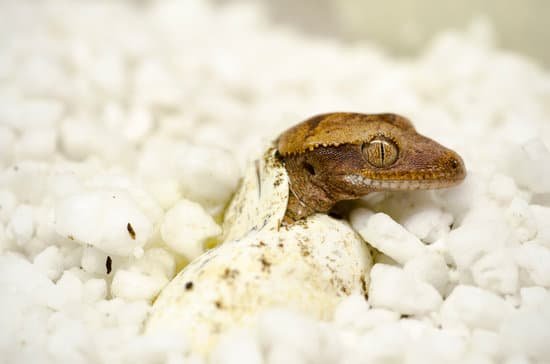
Crested geckos lay eggs, in the breeding season. Female crested geckos lay 2 – 3 eggs every 30 – 45 days.
Crested gecko eggs will develop naturally in room temperature (around 75 °F or 26 °C). The development process will take around 60 days for eggs to hatch.
But in colder conditions, such as a state like North Dakota, You might expect your crested gecko eggs to hatch after 3 to 4 months.
What Does A Fertile Crested Gecko Egg Look Like?
You can know whether a crested gecko egg is fertile by its color and texture. Fertile crested geckos eggs are white and solid. However, do not throw away infertile eggs because they may still hatch.
you will be able to see red veins in a fertile egg using the candling techniques while the infertile egg doesn’t show such. The more fetile and developed the egg, the less light would be able to pass through.
After three weeks (21 days) of incubation, you can then determine whether the egg is infertile. Candling is another popular method used for determining whether an egg is fertile or not.
You can just use a keychain type flashlight or big Maglite for the candling process.
Once you shine the beam and the egg is pinkish, then it is likely fertile.
Note: Do not roll crested gecko eggs or shift it from its original position because it can drown the hatchling.
How Many Eggs Can You Incubate At A Time?
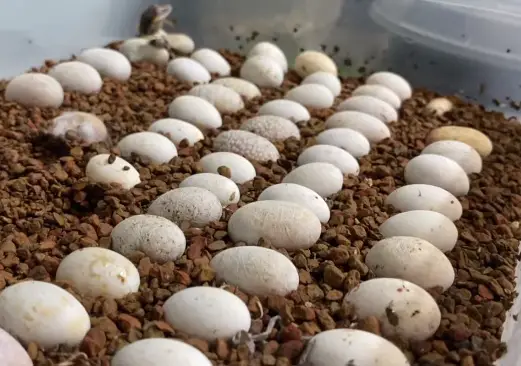
The number of crested gecko eggs that you can incubate at once is dependent on the incubator that you are using. Some good reptile incubators can accommodate only one egg, while some can accommodate up to 100 eggs at a time.
However, female cresties will lay a clutch of two eggs every 30 to 45 days during a breeding season.
Do You Need An Incubator?
Crested geckos eggs can be incubated whether in a room or an incubator. For successful hatching, you will need to ensure that there are constant temperatures and humidity inside and close to the incubator.
The optimum temperature and humidity for incubating crested geckos eggs are 68-80oF and 85-90%, respectively.
The gender of lizards depends on the temperature during incubation time. You can determine what the sex of your crested gecko will be by using the temperature of the incubator.
If you incubate the eggs at a higher temperature between 80-84oF, you can create more males.
However, you can create more females if you incubate the eggs under a lower temperature between 68-73oF.
Incubating Crested Geckos’ Eggs in a Room Without an Incubator
You can easily incubate crested geckos eggs in a room if you can maintain the optimum temperature needed for hatching. The temperature and humidity of the room need to be as constant as possible.
You will also need to mist the substrate and the eggs if you are using a room to incubate eggs. This is mainly because the moisture in the substrate will evaporate through the holes.
You will need to take temperature readings using the hygrometer and thermometer with a probe, as much as possible.
Using an Incubator For Incubating Eggs
The major benefit of using an incubator is that you can automatically regulate the constant temperature and humidity. You can also cool down the containers with eggs when needed.
There are several incubators suitable for incubating reptile eggs, and it is best to go for one that can hold consistent temperatures.
However, if you need an incubator but not ready to buy one, you can easily make your DIY reptile incubator. You can modify a 10-gallon aquarium to make an incubator.
You need to simply add a few inches of water and then use the aquarium heater to heat the tank to the specified temperature. You will then place a brick in the water where you will place the container with the eggs.
Cover the top to keep the heat and moisture in the tank.
Other Accessories to Successfully Incubate a Crested Gecko Egg
- Egg trays
- Egg box
- Incubating mediums like Perlite, Vermiculite, Pangea
- Thermometer
- Hygrometer
New to crested gecko? Check out the crested gecko care sheet now! We had listed out all the things you need to know about crested geckos as pets. Check it now!
How To Incubate Crested Gecko Eggs?
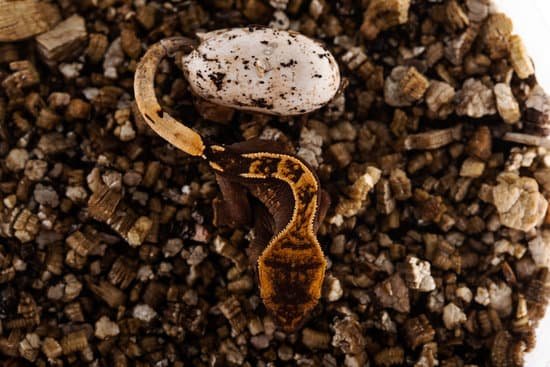
Crested geckos are among the easiest geckos that you can incubate. The first thing to do is slowly excavate the egg slowly and make sure that you mark the egg top.
This helps to avoid rotating the egg as the embryo can detach and prevent drowning the hatchlings.
Another reason to mark the egg is to easily set the egg back into the normal position if another hatchling mistakenly rolled it. You can candle your crested geckos to determine if they are fertile.
However, it is best to incubate both the fertile eggs and infertile eggs just to be sure.
To answer how to incubate crested gecko egg, we can make it simple.
- Collect your crested gecko eggs.
- Put it inside an incubation box or an incubator.
- Ensure the room temperature is around 75 °F.
- Wait for at least 60 – 70 days for the eggs to hatch.
- Wait up to 3 – 4 months if you live in colder states.
You can use two mediums to incubate your eggs namely perlite and Vermiculite
Perlite
- Fill up the medium.
- Measure the perlite on a scale.
- It is best to use one part of perlite to 0.8g of water or make it 1:1
Vermiculite
You will follow the same process for Vermiculite.
Note: When adding water, ensure that the medium is soaked with water, but it is not dripping. You can use both Perlite and Vermiculite for incubating the egg. You can also use a Pangea hatch for incubating crested geckos eggs.
Pangea Hatch
Fill your cup with as much Pangea hatch you want and run it under a tap and watch it change color. Drop it in a colander to remove the water.
Temperature During Hatching
It is best to incubate your eggs at the same temperature that your crested geckos are in. The suitable temperature should be between 70-79oF.
You can keep a constant temperature by placing the deli cup with eggs in an insulated cooler. Then place a thermometer for reading the temperature.
Maintenance Routine
With a Pangea hatch, you do not need to add more water. However, you will need to add water with perlite. When adding water, ensure you do not add it on top of the eggs as it can crack.
You can add water by spraying a little water on the edge of the cup or the place you are keeping the eggs.
Ensure that the temperature and humidity inside and around the incubator are constant.
How Long Does it Take for an Egg to Hatch Successfully?
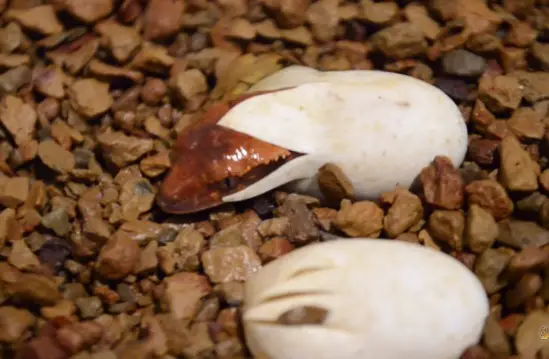
On average, when you incubate your crested geckos with a temperature between 72-75oF, they will hatch around three months. Your eggs will start hatching anywhere from two to four months.
However, you will need to be patient with your eggs if they have not hatched after three months and they still look good.
Note: you will put a hole on the top of the lid and the bottom of the cup for ventilation. This is because the eggs will breathe. If you do not put a hole on the cup you are using, ensure that you check on the eggs every week.
Signs Of a Dead Crested Gecko Egg
You can identify dead and infertile crested gecko eggs by their color and texture.
- The eggs will become yellow and look dried out.
- The eggs will be moldy when incubating them.
- The egg will be flat with a poorly formed shell.
- You can try with the water waving method after the hatch period.
Candling Crested Gecko Eggs
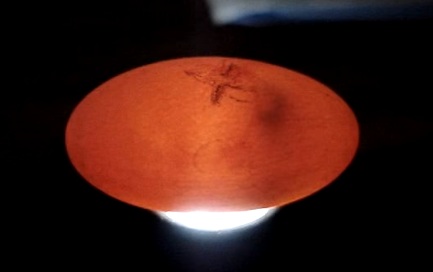
This is an effective method that you can use to check your crested geckos’ egg’s viability and progress. Candling is the process of using a bright light source to see through the semi-translucent shell of eggs.
All you need to do is hold the egg over the top of the light to see what is inside.
However, you need to avoid rolling the egg over to prevent drowning the hatchlings. You will see red veins that start forming after the egg is laid for fertile eggs.
Infertile eggs do not form veins, and their color is usually yellow.
Note: you should try to incubate the infertile eggs and wait and see if they will develop over time.
Once your crested gecko’s hatchlings start developing, the egg will become darker as the gecko starts taking up space. It will be harder for light to pass through the egg during this period.
New to crested gecko? Check out the crested gecko care sheet now! We had listed out all the things you need to know about crested geckos as pets. Check it now!
Interfering During Crested Geckos Egg Hatching
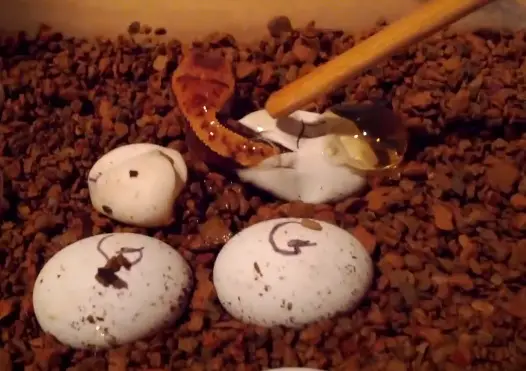
(Source: Playswithfish72 YouTube)
Once you notice that the eggs start hatching, there is no need for you to intervene. Crested geckos eggs will not take long to hatch, and it is possible to check your incubator and find out.
However, there are extreme situations where crested geckos owners may need to open the egg manually.
What to Remember When Taking Care of Baby Cresties?
Baby crested geckos are also known as hatchlings, and they need special housing and high humidity for easy shedding. Baby cresties need appropriate care and diet for them to grow into healthy adults.
Some of the things to consider when caring for baby cresties are stated below.
Baby Crested Gecko Diet
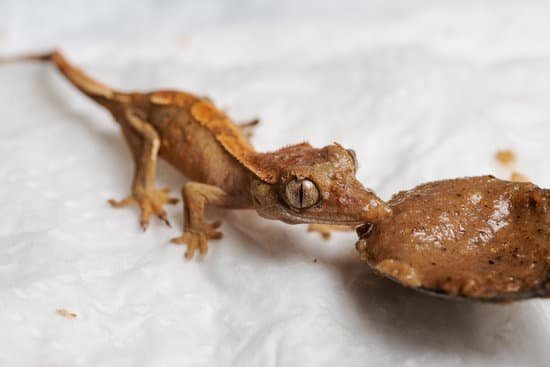
Crested geckos hatchlings will feed on the yolk sac for the first few days after hatching. This means you do not have to feed them until after its first shedding. The first shedding occurs between 2-3 days after hatching.
However, you can place food in their container 24-48 hours after they hatched to ensure they can feed when ready.
Crested geckos can be fed with a self-made fruit diet or commercial crested gecko food.
Feeding Insects to Baby Crested Geckos
You can introduce insects to your baby cresties about a month after hatching. However, you need to make sure that the insects are not bigger than the width of your crested gecko’s head.
You will also need to gut-load or dust the insects with calcium and Vitamin D3 powder before giving them to your gecko.
Water
Water is essential in baby cresties’ diet for good growth. However, they can get it from drinking droplets of water on the leaves after misting. But you will still need to place a water bowl in their enclosure.
Ensure that the bowl contains a shallow amount of water to prevent the accidental drowning of your gecko.
What Not To Feed Baby Cresties?
Baby food: In the past, many crested geckos owners fed their geckos with baby food. They use the fruit-based baby food to replace the fresh fruit diet. It usually consists of a mix of chicken, fruit, meat or baby food.
However, baby food is filled with high amounts of sugar, additives, and preservatives, which can be bad for your baby cresties. This is why it is best to avoid them and use healthy alternatives.
Large insects: Insects are considered as a perfect diet to supplement your cresties diet, but you should avoid feeding your baby cresties with large insects.
Feeding baby geckos with large insects can cause impaction. You need to make sure the insects you feed your hatchlings are not larger than the space between their eyes.
Citrus fruits: Citrus fruits should be avoided when feeding baby cresties because they are harmful to cresties. This is because of the presence of citric acid in citrus fruits. However, you can give it to your cresties only as treats once a month.
Check our complete guide on baby crested gecko care.
Tank size & How Many Baby Cresties in One Tank are Good?
There is a need to set up a safe environment for your gecko’s hatchlings after hatching. This is because you will need to transfer them about 12 hours after they hatch. You can get a new tank online or from your local pet store.
When it comes to housing, you can use the same requirement for adult and baby crested geckos. They need humidity around 50-80%, while the temperature should be around 72-78oF during the day.
You can provide them with indirect sunlight or artificial light for 12-14 hours per day.
You do not need to provide special lighting at night. However, you can keep baby crested geckos in a small container. The tank can be between 1.5 to 5 gallons like the critter keeper or fusarium.
Baby crested geckos need smaller enclosures because they will find it hard to find food in a larger tank. It is best to provide them with a small environment with few plants or branches.
You can place a heat mat under their tank to keep them warm.
It is best to use a paper towel as a substrate for baby crested gecko tanks. You can provide small tubes and structures for them to hide whenever they want.
You can house baby crested geckos together in a large terrarium. However, you will need to separate them as they grow bigger because they will not fit in a normal terrarium.
Another reason to separate them is when you notice that they are getting aggressive towards each other.
Conclusion
Hatching of crested geckos eggs is a simple process even for new breeders. By following the steps above, you should be able to get a 100% success rate.
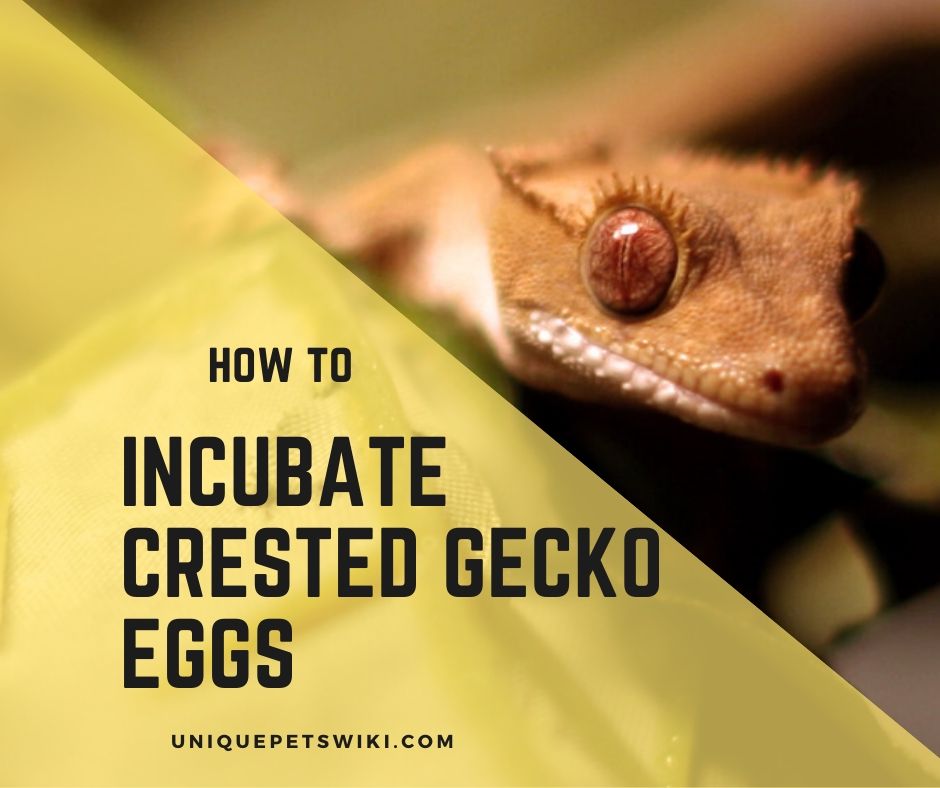
Hi,
I bought superhatch and a digital thermometer and was wondering how I go about setting this up together. If there was some tip I could get. I’ve had had 30 plus crested gecko eggs and only 3 successes. So I’ve got this stuff this time around in hopes for some new success.